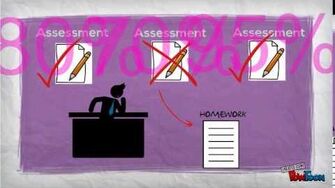
What is Mastery Learning?-0

Mastery Learning Implemented

TEDxNYED - Jeff Jarvis - 03 06 10

Mastery Learning

Welcome to our Flipped Mastery Classroom

Daphne Koller What we're learning from online education

Personalized Mastery Learning

Mastery learning

PCTL Forget Edutainment Implement Mastery Learning to Foster Student Success
Mastery Learning[]
There is a school of thought that presumes all people can learn if they are provided with the appropriate learning conditions. Learning for mastery or mastery learning, are terms coined by Benjamin Bloom in 1968 and 1971 respectively. Bloom hypothesized that a classroom with a mastery learning focus as opposed to the traditional form of instruction would reduce the achievement gaps between varying groups of students (Guskey 2007). In Mastery learning, "the students are helped to master each learning unit before proceeding to a more advanced learning task" (Bloom 1985) in contrast to "conventional instruction".
Mastery learning has little to do with specific content, but rather is a description of the process of mastering particular learning objectives. This approach is based on Benjamin Bloom's Mastery for Learning model, with refinements made by Block. Mastery learning may be implemented as teacher-paced group instruction, one-to-one tutoring, or self-paced learning with programmed materials. It may involve direct teacher instruction, cooperation with classmates, or independent learning. It requires well-defined learning objectives organized into smaller, sequentially organized units. Individualized instruction has some elements in common with mastery learning, although it dispenses with group activities in favor of allowing more able or more motivated students to progress ahead of others and maximizing teacher interaction with those students who need the most assistance.
In one meta-analysis (Kulik, Kulik & Bangert-Drowns, 1990), the mean effect size (Cohen's d) of 103 studies was 0.52, which is considered a moderately large effect size.
The concept of mastery learning can be attributed to the behaviorism principles of operant conditioning. According to operant conditioning theory, learning occurs when an association is formed between a stimulus and response (Skinner, 1984). In line with the behavior theory, mastery learning focuses on overt behaviors that can be observed and measured (Baum, 2005). The material that will be taught to mastery is broken down into small discrete lessons that follow a logical progression. In order to demonstrate mastery over each lesson, students must be able to overtly show evidence of understanding of the material before moving to the next lesson (Anderson, 2000).
In 2008, Jon Bergmann and Aaron Sams began to embrace what they call the Flipped-Mastery model. This is mastery learning that used technology to time-shift the individual instruction. They created videos for each learning objective and posted these online so that as students moved through the content, they were able to move at their own pace. Technology freed up the teachers to individualize the learning for each student. (Bergmann, Sams 2012)
Mastery Learning Implementation[]
- The teaching material is organized to follow a logical progression.
- The teaching material is broken down into small discrete lessons that follow a logical progression.
References[]
- Anderson, J. R. (2000). Learning and memory: An integrated approach (2nd ed.). New York: John Wiley and Sons, Inc.
- Baum, W. M. (2005). Understanding Behaviorism: Behavior, Culture and Evolution. Malden, MA: Blackwell Publishing.
- Bergmann, Sams (2012). Flip Your Classroom: Reach Every Student in Every Class Every Day, ISTE ISBN 1564843157
- Block, Schools, Society and Mastery Learning. ISBN 978-0-03-088407-8
- Grittner, F. M. (1975). Individualized instruction: An historical perspective. The Modern Language Journal, 323 333.
- Guskey, T. R., & Gates, S. (1986). Synthesis of research on the effects of mastery learning in elementary and secondary classrooms. Educational Leadership, 43, 73-80.
- Guskey, T.R. (2007). Closing Achievement Gaps:Revisiting Benjamin S. Bloom’s “Learning for Mastery. Journal of Advanced Academics. 19, 8-31.
- Kulik, C., Kulik, J., & Bangert-Drowns, R. (1990). Effectiveness of mastery learning programs: A meta-analysis. Review of Educational Research, 60(2), 265-306.
- Skinner, B. F. (1984). The evolution of behavior. Journal of Experimental Analysis of Behavior, 41, 217-221.